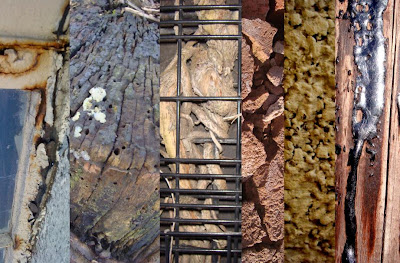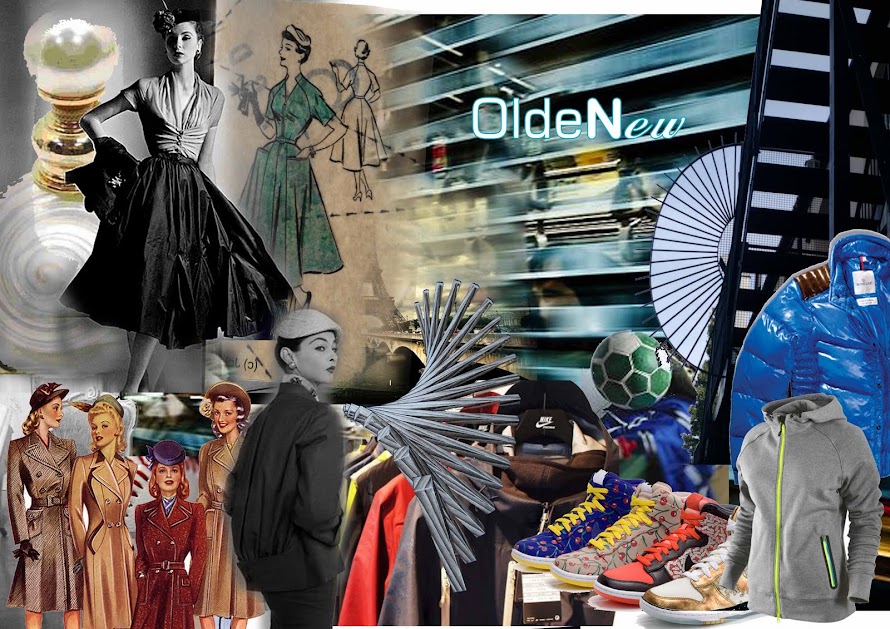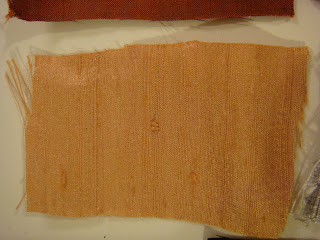
Wednesday, 24 February 2010
Tuesday, 23 February 2010
FABrics!!~19th Feb 2010

Abstract silk satin – The blots project a blurry version of the images I took of ‘shattered’ pebbles. The texture of this is lovely – silky, slithering and warm. It also looks like holes/cavities that form on tree barks -again this is in my research. Could work!

Borovicks


^Some leather samples in colours of my concept board and also with slight distressed effects. However I found the back of the black piece more interesting. The worn out areas of the suede like side gave me the impression of splattered paint (graffiti) on concrete or worn off paint on the roads.


more Woven cotton - again natural colours but roughly mixed down grains.
 Blue crinkled silk - the actual fabric actually has large blots of dark ink/dye giving an uneven sea wave effect.
Blue crinkled silk - the actual fabric actually has large blots of dark ink/dye giving an uneven sea wave effect.Thursday, 18 February 2010
McQueen lives on
Wednesday, 17 February 2010
Properties of Fabrics

VISCOSE:
Viscose is a form of wood cellulose (wood pulp from trees) that is used in the manufacture of products for the medical industry. Viscose combined with natural and man made fibres can also be formed into a rayon, which is a textile that can also be used for clothes.
How it is made:
The cellulose (wood pulp) is dissolved and then reformed into filaments by chemical and mechanical processes. The filaments are produced via nozzles of various sizes and are can be twisted, stretched or doubled. The variation enables manufactures to produce and develop fabrics of different weight and properties.
Characteristics:
- Viscose has a silky appearance and feel.
- More elasticity than silk.
- It is lightweight and drapes very well.
- Breathable,similar to cotton weaves.
- Good for dyeing.
- However it creases very easily and therefore requires high maintenance.
 SILK
SILK A natural protein fibre.
How it is made:
Silk is obtained from cocoons produced by silk worms.
Characteristics:
- Shimmering and reflective appearance is due to the prism structured fibres.
- Smooth, soft texture but NOT slippery.
- Drapes well.
- One of the strongest natural fibres.
- Elasticity is poor - if stretched,it will remain stretched.
- Can be weakened if exposed to too much sunlight.
- Can shrink - Silk Chiffon can shrink upto 8% if wet. Therefore fabric should be washed prior to contructing garment.
- Resistant to mineral acids but sulphuric acid can dissolve it.
- Good absorbency - comfortable to be worn in warm weather.
- Low conduction keeps warm air near skin in cold weather.
WOOL
Another natural protein fibre frm the follicles of sheep. Other 'wool' may come from goats (cashmere, mohair) and camels.
How it is made:
Wool is shaved off sheep and then cleaned (scoured) either simply emersing it hot water or through chemical processes. Semi-greased wool (cleaned with milder detergents) may be worked into yarn and then used for knitting.
Characteristics:
- Crimped texture.
- Has elasticity.
- Able to retain heat.
- Highly absorbent - upto a third of its own weight.
- Ignites at a higher temperature than cotton - a textile used for firefighters.
- Does not melt, low flame spread and low heat release.
- Resistant to static electricity - does not cling to body.

SILK + WOOL = Drapes well (less flowing than silk and more stable), creates a textured effect, both are insulating, high durability, wool is softened by the silk, less bulky than wool. Excellent for tailored garments.
Tuesday, 16 February 2010
FABRIC research
 So the dress composed of 54% Wool and 46% Silk. Other dresses seemed to be of the same composition or just silk (As the labels were deep down inside the garments it was difficult going around trying to look into every garment and fitting rooms were a little bit intimidating!). However I have looked on the website and it briefly tells you what the garment is made of but without the percentages:
So the dress composed of 54% Wool and 46% Silk. Other dresses seemed to be of the same composition or just silk (As the labels were deep down inside the garments it was difficult going around trying to look into every garment and fitting rooms were a little bit intimidating!). However I have looked on the website and it briefly tells you what the garment is made of but without the percentages: ^ Lycra
^ LycraMonday, 15 February 2010
CONCEPT board

Changed slightly:


PDP: 12th Feb

From this I will attempt to develop a concept board!
Thursday, 11 February 2010
R.I.P.
Fashion will feel an emptiness without you.
Rest in Peace
Lee Alexander McQueen 1969-2010
x













